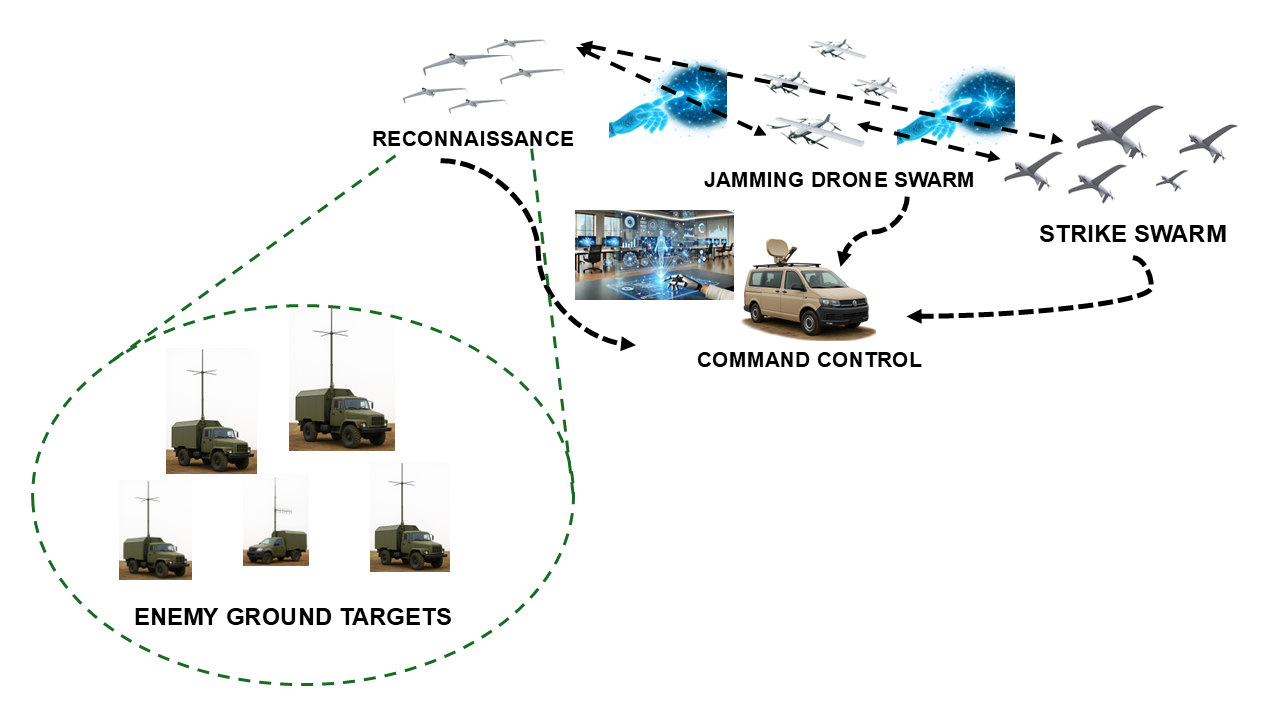Conceptual foundations of the swarm employment of unmanned aerial vehicles as intelligent means of electronic warfare
DOI:
https://doi.org/10.15587/2706-5448.2025.329989Keywords:
swarm, obstacles, technologies, system, efficiency, integration, algorithm, methods, countermeasure, controlAbstract
The object of research is the process of functioning of a swarm of unmanned aerial vehicles (UAVs), equipped with artificial intelligence technologies, as intelligent means of electronic warfare (EW). The main attention is focused on their interaction and efficiency of functioning, their adaptive capabilities in a dynamically changing and complex electromagnetic environment.
One of the key problems is ensuring reliable, stable and flexible coordination of swarm actions in conditions of electromagnetic influence of enemy radioelectronic means (REM). Coordination of swarm actions and measures should include continuous monitoring of the spectrum, timely adaptation to enemy countermeasures.
To solve this problem, it is proposed to create an adaptive swarm architecture that implements the principles of decentralized control using machine learning algorithms, a multi-agent approach and software-configuration architecture of radio systems (SDR). The developed approach is based on the application of cognitive strategies for interaction between UAVs and the formation of a dynamic network structure that is self-repairing in the event of damage or interference.
The proposed conceptual approach allows for significantly increasing the effectiveness of influencing the enemy's REM environment through dynamic spatial-temporal distribution of interference, taking into account the tactical situation and spectral characteristics of threats.
It is envisaged to integrate strike and reconnaissance UAVs into a single swarm structure with autonomous coordination of actions, which expands the functionality of the swarm from the placement of multi-frequency interference to the detection, tracking and neutralization of critically important objects.
This approach provides a high level of autonomy, adaptability and survivability of unmanned platforms in difficult conditions of electronic warfare, and also creates the prerequisites for significantly increasing the effectiveness of combat operations in a modern high-tech environment by integrating reconnaissance and strike functions and EW means into a single information system.
References
- Clark, B. (2022). The Fall and Rise of Russian Electronic Warfare. IEEE Spectrum. Available at: https://spectrum.ieee.org/the-fall-and-rise-of-russian-electronic-warfare
- Edmonds, J. A., Bendett, S. (2023). Russia’s Use of Uncrewed Systems in Ukraine. CNA Research Memorandum, DRM-2022-U-034223-Final. Available at: https://www.cna.org/reports/2023/05/Russias-Use-of-Uncrewed-Systems-in-Ukraine.pdf
- Sliusar, V. I. (2001). Mikroplany: ot shedevrov konstruirovaniia k seriinym sistemam. Konstruktor, 8, 58–59. Available at: https://slyusar.kiev.ua/rk0102_SLYUSAR.pdf
- Kovtunenko, O. P., Bohucharskyi, V. V., Sliusar, V. I., Fedorov, P. M. (2006). Zbroia na netradytsiinykh pryntsypakh dii (stan, tendentsii, pryntsypy dii ta zakhyst vid nei). Poltava: PVIZ, 248. Available at: https://slyusar.kiev.ua/NOTTRAD.pdf
- Terenyk, D., Kharchenko, V. (2024). Choosing strategies for deployment and ensuring the reliability of a UAV swarm to support communications in destruction conditions. Innovative technologies and scientific solutions for industries, 3 (29), 91–103. https://doi.org/10.30837/2522-9818.2024.3.091
- Horbulin, В. P., Mosov, С. P. (2024). Drone swarms are the culmination of the droneization of wars. Visnik Nacionalnoi Academii Nauk Ukraini, 3, 3–11. https://doi.org/10.15407/visn2024.03.003
- Ricardo, J. A., Giacomossi, L., Trentin, J. F. S., Brancalion, J. F. B., Maximo, M. R. O. A., Santos, D. A. (2023). Cooperative Threat Engagement Using Drone Swarms. IEEE Access, 11, 9529–9546. https://doi.org/10.1109/access.2023.3239817
- Saska, M., Vonásek, V., Chudoba, J., Thomas, J., Loianno, G., Kumar, V. (2016). Swarm Distribution and Deployment for Cooperative Surveillance by Micro-Aerial Vehicles. Journal of Intelligent & Robotic Systems, 84 (1-4), 469–492. https://doi.org/10.1007/s10846-016-0338-z
- Li, R., Ma, H. (2020). Research on UAV Swarm Cooperative Reconnaissance and Combat Technology. 2020 3rd International Conference on Unmanned Systems (ICUS). Harbin, 996–999. https://doi.org/10.1109/icus50048.2020.9274902
- Chen, W., Liu, J., Guo, H., Kato, N. (2020). Toward Robust and Intelligent Drone Swarm: Challenges and Future Directions. IEEE Network, 34 (4), 278–283. https://doi.org/10.1109/mnet.001.1900521
- Sherman, M., Shao, S., Sun, X., Zheng, J. (2025). Counter UAV Swarms: Challenges, Considerations, and Future Directions in UAV Warfare. IEEE Wireless Communications, 32 (1), 190–196. https://doi.org/10.1109/mwc.003.2400047
- Kim, G. S., Lee, S., Woo, T., Park, S. (2024). Cooperative Reinforcement Learning for Military Drones over Large-Scale Battlefields. IEEE Transactions on Intelligent Vehicles, 1–11. https://doi.org/10.1109/tiv.2024.3472213
- Wang, S., Liu, Z., Nie, C., Zhang, Y. (2024). Large-Scale Drone Swarm Countermeasures Technology Based on MF-Q Algorithm. 2024 5th International Seminar on Artificial Intelligence, Networking and Information Technology (AINIT). Nanjing, 125–129. https://doi.org/10.1109/ainit61980.2024.10581464
- Zhou, Z., Tang, J., Feng, W., Wong, K. K. (2023). Energy-aware Routing Protocol for UAV Electronic Warfare using Graph Attention and Fuzzy Reward. GLOBECOM 2023 – 2023 IEEE Global Communications Conference, 1860–1865. https://doi.org/10.1109/globecom54140.2023.10437213
- Demirbaga, U., Aujla, G. S., Singh, M., Singh, A., Sun, H., Camp, J. (2024). An Intelligent Monitoring and Warning Framework in Drone Swarm Digital Twin Systems. ICC 2024 – IEEE International Conference on Communications. Denver 1945–1950. https://doi.org/10.1109/icc51166.2024.10622736
- Xiaoning, Z. (2020). Analysis of military application of UAV swarm technology. 2020 3rd International Conference on Unmanned Systems (ICUS). Harbin, 1200–1204. https://doi.org/10.1109/icus50048.2020.9274974
- Aboltins, A., Tihomorskis, N. (2023). Software-Defined Radio Implementation and Performance Evaluation of Frequency-Modulated Antipodal Chaos Shift Keying Communication System. Electronics, 12 (5), 1240. https://doi.org/10.3390/electronics12051240
- Zitouni, R., Bouaroua, H., Senouci, B. (2025). Hardware-Software Codesign for Software Defined Radio: IEEE 802.11p Receiver Case Study. arXiv preprint. https://doi.org/10.48550/arXiv.2003.09525
- Dong, Y., Wu, F., Zhang, S., Chen, G., Hu, Y., Yano, M. (2025). Securing the Skies: A Comprehensive Survey on Anti-UAV Methods, Benchmarking, and Future Directions. arXiv preprint. https://doi.org/10.48550/arXiv.2504.11967
- Slyusar, V. (2020). Situation Awareness Exchange Methods for a Swarm of Autonomous Systems. EasyChair Preprint No. 4513. https://doi.org/10.13140/RG.2.2.19829.81125
- Kaelbling, L. P., Littman, M. L., Moore, A. W. (1996). Reinforcement Learning: A Survey. Journal of Artificial Intelligence Research, 4, 237–285. https://doi.org/10.1613/jair.301
- Sutton, R. S., Barto, A. G. (1998). Reinforcement Learning: An Introduction. IEEE Transactions on Neural Networks, 9 (5), 1054–1054. https://doi.org/10.1109/tnn.1998.712192
- Slyusar, V., Protsenko, M., Chernukha, A., Melkin, V., Biloborodov, O., Samoilenko, M. et al. (2022). Improving the model of object detection on aerial photographs and video in unmanned aerial systems. Eastern-European Journal of Enterprise Technologies, 1 (9 (115)), 24–34. https://doi.org/10.15587/1729-4061.2022.252876
- Slyusar, V. (2019). Ukraine's Update to JCG GBAD. JCG GBAD Meeting. https://doi.org/10.13140/RG.2.2.18389.54242
- Alqudsi, Y., Makaraci, M. (2025). UAV swarms: research, challenges, and future directions. Journal of Engineering and Applied Science, 72 (1). https://doi.org/10.1186/s44147-025-00582-3
- Slyusar, V. I., Smolyar, V. G. (2003). Communication channels frequency multiplexing on the basis of superrayleigh signals resolution. Izvestiya Vysshikh Uchebnykh Zavedenij. Radioelektronika, 46 (7). Available at: https://www.researchgate.net/publication/293151202_Communication_channels_multiplexing_on_the_basis_of_superrayleigh_signals_resolution_with_respect_to_arrival_time
- Slyusar, V. I., Smolyar, V. G. (2004). Non-orthogonal discrete frequency signal modulation method for narrowband communication channels. Izvestiya Vysshikh Uchebnykh Zavedenij. Radioelektronika, 47 (4). Available at: https://www.researchgate.net/publication/293141781_Non-orthogonal_discrete_frequency_signal_modulation_method_for_narrowband_communication_channels
- Slyusar, V., Bihun, N. (2024). Integrating Mixture of Experts into Transformers Architecture to Control UAV Swarms. The 14-th IEEE International Conference on Dependable Systems, Services and Technologies. DESSERT’2024. Athens, 6.
- Joint Chiefs of Staff, Joint Publication 3-60: Joint Targeting (2018). Washington. Available at: https://www.esd.whs.mil/Portals/54/Documents/FOID/Reading%20Room/Joint_Staff/21-F-0520_JP_3-60_9-28-2018.pdf
- ATP 2-01.3: Intelligence Preparation of the Battlefield. Washington: Headquarters, Department of the Army. Available at: https://home.army.mil/wood/application/files/8915/5751/8365/ATP_2-01.3_Intelligence_Preparation_of_the_Battlefield.pdf
- NATO STANAG 4670 – ATP-3.3.7 (2014). Guidance for the Training of Unmanned Aircraft Systems (UAS) Operators. NATO Standardization Agency. Available at: http://everyspec.com/NATO/NATO-STANAG/download.php?spec=SRANAG-4670_ED-3.052054.pdf Last accessed: 14.02.2025
- Dovbysh, I. O., Muraviov, O. V., Galagan, R. M., Bohdan, H. A., Momot, A. S. (2023). Power systems and energy sources of modern uavs. Scientific Notes of Taurida National V. I. Vernadsky University. Series: Technical Sciences, 5, 16–21. https://doi.org/10.32782/2663-5941/2023.5/04
- Pham, K. L., Leuchter, J., Bystricky, R., Andrle, M., Pham, N. N., Pham, V. T. (2022). The Study of Electrical Energy Power Supply System for UAVs Based on the Energy Storage Technology. Aerospace, 9 (9), 500. https://doi.org/10.3390/aerospace9090500
- Swider-Lyons, K. E., Stroman, R. O., Rodgers, J., Page, G. (2016). Hydrogen Fuel Cells for Small Unmanned Air Vehicles. Presented at the 2016 U.S. Department of Energy Hydrogen and Fuel Cells Program and Vehicle Technologies Office Annual Merit Review and Peer Evaluation Meeting. Washington. Available at: https://www.energy.gov/sites/prod/files/2016/05/f32/fcto_webinarslides_h2_fc_small_unmanned_air_vehicles_052616.pdf
- Shen, Z., Liu, S., Zhu, W., Ren, D., Feng, Y., Xu, Q. (2024). A Review on Key Technologies and Developments of Hydrogen Fuel Cell Multi-rotor Drones. https://doi.org/10.20944/preprints202402.0484.v1
- Genovese, M., Fragiacomo, P. (2023). Hydrogen refueling station: Overview of the technological status and research enhancement. Journal of Energy Storage, 61, 106758. https://doi.org/10.1016/j.est.2023.106758
- MIL-DTL-83133F Detail Specification Turbine Fuel, Aviation, Kerosene Type, JP-8 (NATO F-34), NATO F-35, and JP-8+100 (NATO F-37). Available at: http://everyspec.com/MIL-SPECS/MIL-SPECS-MIL-DTL/download.php?spec=MIL-DTL-83133F.011933.pdf Last accessed: 14.02.2025
- Jiao, S., Zhang, G., Zhou, M., Li, G. (2023). A Comprehensive Review of Research Hotspots on Battery Management Systems for UAVs. IEEE Access, 11, 84636–84650. https://doi.org/10.1109/access.2023.3301989
- Muñoz-Zavala, A. E., Macías-Díaz, J. E., Alba-Cuéllar, D., Guerrero-Díaz-de-León, J. A. (2024). A Literature Review on Some Trends in Artificial Neural Networks for Modeling and Simulation with Time Series. Algorithms, 17 (2), 76. https://doi.org/10.3390/a17020076
- François-Lavet, V., Henderson, P., Islam, R., Bellemare, M. G., Pineau, J. (2018). An Introduction to Deep Reinforcement Learning. Foundations and Trends® in Machine Learning, 11 (3-4), 219–354. https://doi.org/10.1561/2200000071

Downloads
Published
How to Cite
Issue
Section
License
Copyright (c) 2025 Vadym Slyusar, Vadym Kozlov, Serhii Pochernin, Iryna Nalapko

This work is licensed under a Creative Commons Attribution 4.0 International License.
The consolidation and conditions for the transfer of copyright (identification of authorship) is carried out in the License Agreement. In particular, the authors reserve the right to the authorship of their manuscript and transfer the first publication of this work to the journal under the terms of the Creative Commons CC BY license. At the same time, they have the right to conclude on their own additional agreements concerning the non-exclusive distribution of the work in the form in which it was published by this journal, but provided that the link to the first publication of the article in this journal is preserved.







